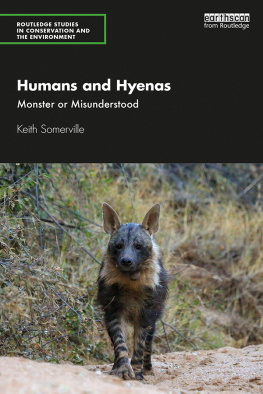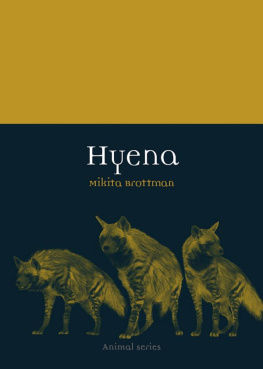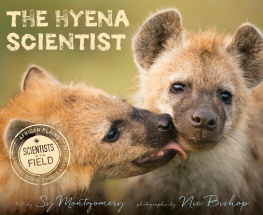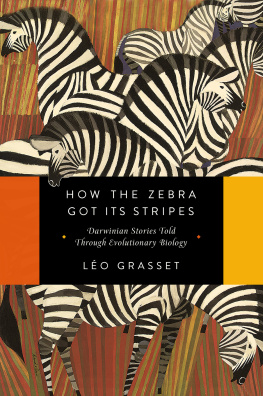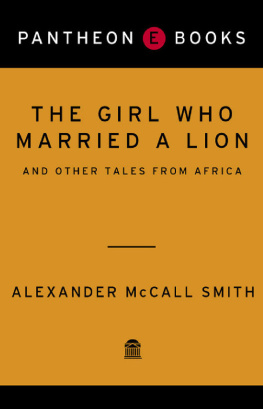Humans and Hyenas
Humans and Hyenas examines the origins and development of the relationship between the two to present an accurate and realistic picture of the hyena and its interactions with people. The hyena is one of the most maligned, misrepresented and defamed mammals. It is still, despite decades of research-led knowledge, seen as a skulking, cowardly scavenger rather than a successful hunter with complex family and communal systems.
Hyenas are portrayed as sex-shifting deviants, grave robbers and attackers of children in everything from African folk tales through Greek and Roman accounts of animal life, to Disneys The Lion King depicting hyenas with a lack of respect and disgust, despite the reality of their behaviour and social structures. Combining the personal, in-depth mining of scientific papers about the three main species and historical accounts, Keith Somerville delves into our relationship with hyenas from the earliest records from millennia ago, through the accounts by colonisers, to contemporary coexistence, where hyenas and humans are forced into ever closer proximity due to shrinking habitats and loss of prey. Are hyenas fated to retain their bad image or can their amazing ability to adapt to humans more successfully than lions and other predators lead to a shift in perspective?
This book will be of great interest to students and scholars in the environmental sciences, conservation biology, and wildlife and conservation issues.
Keith Somerville is a Member of the Durrell Institute of Conservation and Ecology at the University of Kent, UK, where he is a professor at the Centre for Journalism. He is a Senior Research Fellow at the Institute of Commonwealth Studies, a Fellow of the Zoological Society of London, UK, and a Member of the IUCN CEESP/SSC Sustainable Use and Livelihoods Specialist Group.
ROUTLEDGE STUDIES IN CONSERVATION AND THE ENVIRONMENT
This series includes a wide range of inter-disciplinary approaches to conservation and the environment, integrating perspectives from both social and natural sciences. Topics include, but are not limited to, development, environmental policy and politics, ecosystem change, natural resources (including land, water, oceans and forests), security, wildlife, protected areas, tourism, human-wildlife conflict, agriculture, economics, law and climate change.
Natural Resources, Tourism and Community Livelihoods in Southern Africa
Challenges of Sustainable Development
Edited by Moren T. Stone, Monkgogi Lenao and Naomi Moswete
Leaving Space for Nature
The Critical Role of Area-Based Conservation
Nigel Dudley and Sue Stolton
Power in Conservation
Environmental Anthropology Beyond Political Ecology
Carol Carpenter
Rethinking Wilderness and the Wild
Conflict, Conservation and Co-existence
Edited by Robyn Bartel, Marty Branagan, Fiona Utley and Stephen Harris
Humans and Hyenas
Monster or Misunderstood
Keith Somerville
For more information about this series, please visit: www.routledge.com/Routledge-Studies-in-Conservation-and-the-Environment/book-series/RSICE
First published 2021
by Routledge
2 Park Square, Milton Park, Abingdon, Oxon OX14 4RN
and by Routledge
52 Vanderbilt Avenue, New York, NY 10017
Routledge is an imprint of the Taylor & Francis Group, an informa business
2021 Keith Somerville
The right of Keith Somerville to be identified as author of this work has been asserted by him in accordance with sections 77 and 78 of the Copyright, Designs and Patents Act 1988.
All rights reserved. No part of this book may be reprinted or reproduced or utilised in any form or by any electronic, mechanical, or other means, now known or hereafter invented, including photocopying and recording, or in any information storage or retrieval system, without permission in writing from the publishers.
Trademark notice: Product or corporate names may be trademarks or registered trademarks, and are used only for identification and explanation without intent to infringe.
British Library Cataloguing-in-Publication Data
A catalogue record for this book is available from the British Library
Library of Congress Cataloging-in-Publication Data
Names: Somerville, Keith, author.
Title: Humans and hyenas : monster or misunderstood / Keith Somerville.
Description: Agingdon, Oxon ; New York, NY : Routledge, 2021. |
Series: Routledge studies in conservation and the environment |
Includes bibliographical references and index.
Subjects: LCSH: Hyenas. | Hyenas--Effect of human beings on--History. |
Human beings--Effect of environment on--History. | Human-animal relationships--History.
Classification: LCC QL737.C24 S66 2021 (print) |
LCC QL737.C24 (ebook) | DDC 599.74/3--dc23
LC record available at https://lccn.loc.gov/2020044544
LC ebook record available at https://lccn.loc.gov/2020044545
ISBN: 978-0-367-43642-1 (hbk)
ISBN: 978-0-367-43641-4 (pbk)
ISBN: 978-1-003-00478-3 (ebk)
Due to their appetite for livestock and the occasional human, the great predators are the first wildlife to disappear when people get the technology to kill them efficiently, and the hardest to conserve today. Hyenas compound those sins by also eating human corpses, adding a supernatural dimension that makes them one of the most despised and misunderstood of all animals, a great irony given that the spotted hyena in particular is one of natures most interesting, complex and, to those who know them, loveable creatures. They have been maligned throughout recorded history, and because they were probably one of early mans most dangerous predators and most direct competitors over kills, they have probably held that distinction since the dawn of mankind. With this volume, Keith Somerville has produced the definitive history of the tortured relationship between Homo sapiens and the Hyaenidae, his exhaustive research documenting our mutual history from the distant Pleistocene past to todays headlines and latest scientific studies.
Humans have been eliminating other species since we evolved into hunters nearly two million years ago, culminating in the Pleistocene extinctions of the last 20,000 years. Those saw the disappearance of scores of large mammal species, gradually at first in Eurasia and then very rapidly in the New World soon after humans arrived; we had eaten all of Australias megafauna millennia earlier. Only in Africa and parts of Asia did the largest mammals survive, having had millions of years to gradually evolve behavioural defences against gradually evolving human predation. Today, however, firearms, poison, and the human population growth which resulted from colonialism have reduced Africas wildlife to a small fraction of the numbers present when Europeans arrived. Kenyas great naturalist Leslie Brown estimated that 90% of its wildlife present at the beginning of the colonial period had disappeared by 1940, and that 90% of the remainder was gone by the 1970s. Reliable aerial census data show that it has declined nearly 90% since then. Thus, with more wildlife remaining than most African countries, Kenya has perhaps 0.1% of the large mammal fauna that were present in the 1890s. This book, like Prof. Somervilles previous ones on the ivory trade and the history of lions and humans, documents that cataclysm in excruciating detail.
Predators were far more abundant when our ancestors first domesticated wild grazers 810,000 years ago. The early herders must have developed effective antipredator measures as soon as they had livestock to protect, probably similar to those still used today by traditional African pastoralists. Had they not kept the first livestock in stout bomas (corrals) at night and tended them closely when out grazing by day, large carnivores would have ended the experiment in domestication as soon as it started. Ironically, hyenas are the easiest predator against which to defend livestock: as they cannot jump, a strong boma merely one meter high effectively excludes them. However, ready availability of cheap but lethal agricultural pesticides have made those efforts unnecessary and the great predators, along with the rest of African wildlife, are fast disappearing.

